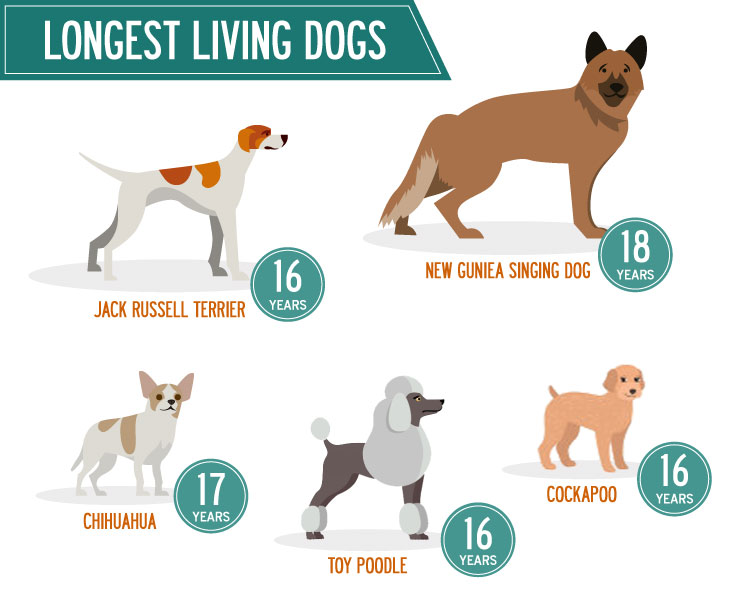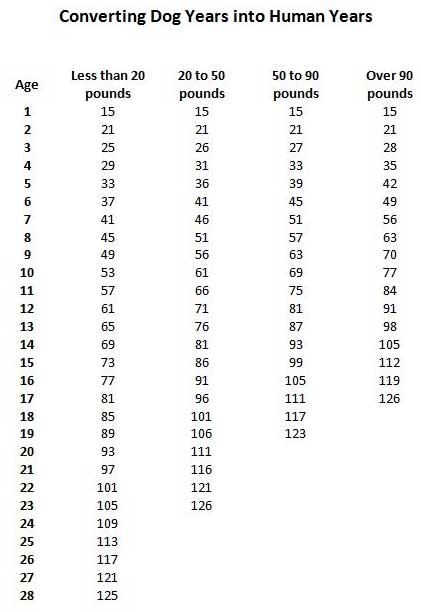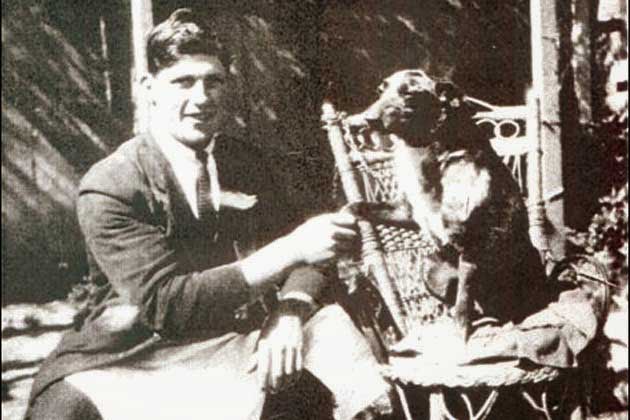What are the longest living dogs
A dog's lifespan might be an influencing factor when making a decision about the type of breed that you would like to adopt or buy. If the matter of how old a dog will live to is a primary factor in your decision here are the Top 5 longest living dogs:

|
Breed
|
Temperament
|
Lifespan
|
|
New Guinea Singing Dog
|
Friendly, Howler
|
18 years
|
|
Chihuahua
|
Courageous, Playful
|
17 years
|
|
Toy Poodle
|
Peace-loving, Playful
|
16 years
|
|
Jack Russell Terrier
|
Courageous, Energetic
|
16 years
|
|
Cockapoo
|
Highly Affectionate, Energetic
|
16 years
|
If the New Guinea Singing Dog does not sound familiar to you, don't fret. New Guinea Singing Dogs are an extremely rare breed of dogs which are only native to Papua New Guinea. There is only an estimated 100 New Guinea Singing Dogs kept as pets in the world.
Average Dog Lifespan Chart
If the above 5 dogs are not your type, the following is an average dog age lifespan chart of the more common breed of dogs. Do keep in mind the eventual age your dog will live to really depends on how much care you give it.
|
Breed
|
Average Lifespan (Years)
|
|
Affenpinscher
|
12-14
|
|
Afghan Hound
|
12-14
|
|
African Boerboels
|
9-11
|
|
Airedale Terrier
|
10-13
|
|
Akbash
|
10-11
|
|
Akita
|
10-13
|
|
Alapaha Blue Blood Bulldogs
|
13
|
|
Alaskan Klee Kai
|
14
|
|
Alaskan Malamute
|
10-13
|
|
American Bulldog
|
12-14
|
|
American Eskimo Dog
|
12-14
|
|
American Foxhound
|
10-13
|
|
American Staffordshire Terrier
|
12-14
|
|
American Water Spaniel
|
10-12
|
|
Anatolian Shepherd Dog
|
10-13
|
|
Australian Cattle Dog
|
10-13
|
|
Australian Kelpie
|
12
|
|
Australian Shepherd
|
12-15
|
|
Australian Silky Terrier
|
11-14
|
|
Australian Terrier
|
12-14
|
|
Basenji
|
12-14
|
|
Basset Hound
|
11-14
|
|
Beagle
|
12-14
|
|
Bearded Collie
|
12-14
|
|
Beauceron
|
10-12
|
|
Bedlington Terrier
|
12-14
|
|
Belgian Malinois
|
10-12
|
|
Belgian Shepherd Dog
|
10-12
|
|
Belgian Tervuren
|
10-12
|
|
Bernese Mountain Dog
|
6-9
|
|
Bichon Frise
|
12-15
|
|
Black and Tan Coonhound
|
10-12
|
|
Black Russian Terrier
|
10-11
|
|
Bloodhound
|
10-12
|
|
Border Collie
|
10-14
|
|
Border Terrier
|
12-15
|
|
Borzoi
|
10-12
|
|
Boston Terrier
|
14
|
|
Bouvier des Flandres
|
10-12
|
|
Boxer
|
8-10
|
|
Briard
|
10-12
|
|
Brittany
|
12-13
|
|
Brussels Griffon
|
12-15
|
|
Bull Terrier
|
11-14
|
|
Bullmastiff
|
8-10
|
|
Cairn Terrier
|
12-14
|
|
Canaan Dog
|
12-13
|
|
Cane Corso
|
11
|
|
Cardigan Welsh Corgi
|
12-14
|
|
Carolina Dog
|
13
|
|
Catahoula Leopard Dogs
|
12
|
|
Cavalier King Charles Spaniel
|
9-14
|
|
Central Asian Ovtcharkas
|
12
|
|
Cesky Terrier
|
14
|
|
Chesapeake Bay Retriever
|
10-13
|
|
Chihuahua
|
14-18
|
|
Chinese Crested
|
13-15
|
|
Chinese Foo
|
11
|
|
Chinese Shar-Pei
|
8-10
|
|
Chipoo
|
14
|
|
Chow Chow
|
8-12
|
|
Clumber Spaniel
|
10-12
|
|
Cocker Spaniel
|
12-15
|
|
Cockapoo
|
14-18
|
|
Collie
|
8-12
|
|
Coton De Tulears
|
15
|
|
Curly-Coated Retriever
|
8-12
|
|
Dachshund
|
12-14
|
|
Dalmatian
|
12-14
|
|
Dandie Dinmont Terrier
|
11-13
|
|
Doberman Pinscher
|
10-12
|
|
Dogue de Bordeaux
|
5-7
|
|
English Bulldogs
|
8-12
|
|
English Cocker Spaniels
|
12-14
|
|
English Foxhound
|
10-13
|
|
English Setter
|
10-12
|
|
English Shepherd
|
15
|
|
English Springer Spaniel
|
10-14
|
|
English Toy Spaniel
|
10-12
|
|
Estrela Mountain Dogs
|
11
|
|
Field Spaniel
|
12-14
|
|
Fila Brasileiros
|
10
|
|
Finnish Spitz
|
12-14
|
|
Flat-Coated Retriever
|
10-13
|
|
Fox Terrier (Smooth)
|
10-13
|
|
Fox Terrier (Wire)
|
10-13
|
|
French Bulldog
|
9-11
|
|
German Pinscher
|
12-15
|
|
German Shepherd
|
10-12
|
|
German Shorthaired Pointer
|
12-14
|
|
German Wirehaired Pointer
|
12-14
|
|
Giant Schnauzer
|
10-12
|
|
Glen of Imaal Terrier
|
10-14
|
|
Golden Retriever
|
10-13
|
|
Goldendoodle
|
14
|
|
Gordon Setter
|
10-12
|
|
Great Dane
|
7-10
|
|
Great Pyrenees
|
10-12
|
|
Greater Swiss Mountain Dog
|
10-12
|
|
Greyhound
|
10-13
|
|
Harrier
|
12-14
|
|
Havanese
|
12-14
|
|
Hungarian Vizsla
|
10-14
|
|
Ibizan Hound
|
12-14
|
|
Irish Setter
|
12-14
|
|
Irish Terrier
|
12-15
|
|
Irish Water Spaniel
|
10-13
|
|
Irish Wolfhound
|
5-7
|
|
Italian Greyhound
|
12-15
|
|
Jack Russell Terrier
|
13
|
|
Japanese Chin
|
12-14
|
|
Keeshond
|
12-14
|
|
Kerry Blue Terrier
|
12-15
|
|
Komondor
|
10-12
|
|
Kooikerhondje
|
13
|
|
Kuvasz
|
9-12
|
|
Labradoodle
|
13
|
|
Labrador Retriever
|
10-12
|
|
Laekenois
|
12
|
|
Lakeland Terrier
|
12-16
|
|
Lancashire Heeler
|
14
|
|
Lhasa Apso
|
12-14
|
|
Löwchen
|
13-15
|
|
Maltese
|
12-14
|
|
Maltipoo
|
13
|
|
Manchester Terrier
|
15-16
|
|
Maremma Sheepdog
|
12
|
|
Mastiff
|
9-11
|
|
Miniature Bull Terrier
|
11-14
|
|
Miniature Pinscher
|
12-14
|
|
Miniature Poodle
|
12-14
|
|
Miniature Schnauzer
|
12-14
|
|
Neapolitan Mastiff
|
8-10
|
|
Newfoundland
|
8-10
|
|
Norfolk Terrier
|
13-15
|
|
Norwegian Buhunds
|
11-13
|
|
Norwegian Elkhound
|
10-12
|
|
Norwich Terrier
|
13-15
|
|
Nova Scotia Duck Tolling Retriever
|
11-13
|
|
Old English Sheepdog
|
10-12
|
|
Otterhound
|
10-13
|
|
Papillon
|
12-15
|
|
Parson Russell Terrier
|
13-15
|
|
Peekapoo
|
13
|
|
Pekingese
|
12-15
|
|
Pembroke Welsh Corgi
|
11-13
|
|
Petit Basset Griffon Vendeen
|
11-14
|
|
Pharaoh Hound
|
11-14
|
|
Pit Bull
|
12-14
|
|
Plott
|
11-13
|
|
Pointer
|
11-15
|
|
Polish Lowland Sheepdog
|
10-14
|
|
Pomapoo
|
13
|
|
Pomeranian
|
12-16
|
|
Poodle (Standard)
|
12-15
|
|
Portuguese Water Dog
|
10-14
|
|
Pug
|
12-15
|
|
Puli
|
10-15
|
|
Rat Terrier
|
16
|
|
Redbone Coonhound
|
11
|
|
Rhodesian Ridgeback
|
10-12
|
|
Rottweiler
|
8-11
|
|
Saint Bernard
|
8-10
|
|
Saluki
|
12-14
|
|
Samoyed
|
10-12
|
|
Schipperke
|
13-15
|
|
Schnoodle
|
13
|
|
Scottish Deerhound
|
7-9
|
|
Scottish Terrier
|
11-13
|
|
Sealyham Terrier
|
11-13
|
|
Shetland Sheepdog
|
12-14
|
|
Shiba Inu
|
12-15
|
|
Shih Tzu
|
11-14
|
|
Siberian Husky
|
11-13
|
|
Silky Terrier
|
11-14
|
|
Skye Terrier
|
12-14
|
|
Snorkie
|
12
|
|
Soft-coated Wheaten Terrier
|
12-14
|
|
Spinone Italiano
|
12-14
|
|
Staffordshire Bull Terrier
|
12-14
|
|
Standard Schnauzer
|
12-14
|
|
Sussex Spaniel
|
11-13
|
|
Swedish Vallhund
|
13
|
|
Thai Ridgeback
|
12
|
|
Tibetan Mastiff
|
11-14
|
|
Tibetan Spaniel
|
14
|
|
Tibetan Terrier
|
12-15
|
|
Toy Fox Terrier
|
13-14
|
|
Toy Manchester Terrier
|
14-16
|
|
Toy Poodle
|
12-14
|
|
Treeing Walker Coonhound
|
12-13
|
|
Vizsla
|
10-14
|
|
Weimaraner
|
10-13
|
|
Welsh Springer Spaniel
|
12-15
|
|
Welsh Terrier
|
12-14
|
|
West Highland White Terrier
|
12-14
|
|
Whippet
|
12-15
|
|
Wirehaired Pointing Griffon
|
12-14
|
|
Xoloitzcuintle
|
13
|
|
Yorkie-Poo
|
14
|
|
Yorkshire Terrier
|
14-16
|

10 Dogs With Short Life Expectancies
Most of the dogs that you will find in this chart are larger breeds. This is because larger dogs tend to have shorter lifespans than smaller ones. Some research shows that this is because larger breeds seem to age quicker. As an example, a Great Dane can gain 100 pounds from its day of birth to its first birthday, whereas a Shih Tzu can weight up to 15 pounds in its entire lifespan. Below is a table of ten dogs with short lifespans.
|
Dog Breed
|
Average Lifespan
|
|
French Mastiff
|
5-8 Years
|
|
Great Dane
|
6-8 Years
|
|
Bernese Mountain Dog
|
6-8 Years
|
|
Irish Wolfhound
|
6-10 Years
|
|
Neapolitan Mastiff
|
7-9 Years
|
|
Leonberger
|
8-9 Years
|
|
Newfoundland
|
8-10 Years
|
|
Saint Bernard
|
8-10 Years
|
|
Scottish Deerhound
|
8-10 Years
|
|
Bloodhound
|
9-11 Years
|
How long do mixed breed dogs live?
For mixed breed dogs, owners can use an individual’s weight to help determine how long he or she would be expected to live. In general, small dogs enjoy longer lives than do their larger counterparts. A recent analysis of veterinary records revealed that dogs under 20 pounds had an average lifespan of 11 years while those over 90 pounds typically lived for only 8 years. Medium and large dogs fell in the middle at around 11 years. (State of Pet Health 2013 Report, Banfield Pet Hospital).

What factor's could determine the lifespan of a dog
Dog Care
As the owner, the way you care for your dog can affect its lifespan significantly. A dog with a proper, nutritious diet and exercise can live longer than one without. In addition, taking your furry friend to annual wellness exams at the veterinarian and getting its booster shots can result in a healthy dog with a longer lifespan.
Dog Size
Research shows that larger dogs live for a shorter period of time when compared to smaller ones. For example, an Irish Wolfhound (average 115 lbs) has an average lifespan of 7 years, while a Jack Russell Terrier (average 15 lbs) can live up to 13-16 years.
Inbreeding vs Cross Breeding
Inbreeding can reduce the lifespan of canines. Cross breed dogs have a longer lifespan in comparison. Inbred dogs have a risk of carrying genes for illnesses that are common to that specific breed. Further, “mutts” who have at least two breeds and commonly more, tend to have the least health problems and live longer than their purebred counterparts.
Spayed/Neutered
Spaying and neutering a puppy at a young age can positively affect a dog’s lifespan. Studies suggest that these surgeries can help reduce the risk of some types of cancer in dogs. Especially cancers affecting the ovaries, breast and testicles. Recent studies show that these benefits may or may not completely accurate but there is no question that your life will be easier without a litter of puppies in your life and this will also be less stress on your pup, which could mean a longer life.
Common signs of aging in dogs
The number of years that your dog has lived does not indicate how many years it has left to live, especially when it comes to dogs. Mainly because a 9-year-old Chihuahua is usually quite active while a Great Dane at that age would be highly lethargic and show definite signs of aging. Identifying the signs of aging is quite important as it helps pet parents to add special supplements, regulate exercise duration, and increase the frequency of veterinary visits. To help you smoothly transition from regular dog care to specialized elderly care, the following is a list of the most common signs of aging in dogs.
Cloudy Eyes/Vision Problems: A general deterioration of vision and cloudy haze over the dog’s eyes.
Frequent Urination: Increased frequency of urination is often an indication of kidney-related health issues, which usually affects elderly dogs.
Confusion: A change in behaviour, which generally includes short-tempered nature, dementia, and confusion.
Difficulty Getting Up: Health issues such as arthritis, hip dysplasia is common among elderly dogs, which often make it difficult for them to get up.
Weight Gain/Loss: Due to change in the metabolic rate, thyroid-related issues, or dietary insufficiency elderly dogs can become overweight or underweight.
General Lethargy:Much like humans, elderly dogs increasingly become lethargic with age. They are often reluctant to play and run around.
Fatty Lumps: Elderly dogs often develop fatty lumps on their skin called lipomas. These are benign and painless tumors that usually affects old dogs.
Frequent and Deeper Sleep: Elderly dogs can spend a lot of time sleeping. Often unresponsive to sounds and disturbances they usually experience a deeper slumber.
Converting dog years into human years
A rough estimate as to how old your dog would live could also be calculated by comparing it against that of a human. This method is the least accurate but could give me an indication of your dog's expected life expectancy, especially if it is not a pure bred breed.

Some other facts to consider would be:
In terms of rate of maturity, a dog’s 1st year is more like 15 years for humans.
A good approach to convert dog-years to human-years is to find out the average lifespan of the breed and the average life expectancy of humans in your country.
If you own an Akita in Japan, then your dog’s 1 year equals your 6.9 years
(Average human life expectancy in Japan is 83.1 years and the dog breed Akita has an average lifespan of 12)
If you own a Rottweiler in The United States, then your dog’s 1 year equals your 8.7 years
(Average human life expectancy in the US is 78.74 years and the dog breed Rottweiler has an average lifespan of 9 years)
What is the oldest dog in the world?

The Australian Cattle Dog is known for having one of the longest life expectancies. There are records of Australian Cattle Dogs living past 20 years old. In fact, the world guiness record for the longest living dog is an Australian Cattle Dog named Bluey who lived 29 years and 5 months. Bluey was obtained as a puppy in 1910 and worked among cattle and sheep for nearly 20 years before being put to sleep on 14 November 1939.
Information about a dog’s expected lifespan won’t help blunt the pain of his or her loss, but it can help owners plan how to best care for their companions during the time you do have together.


























